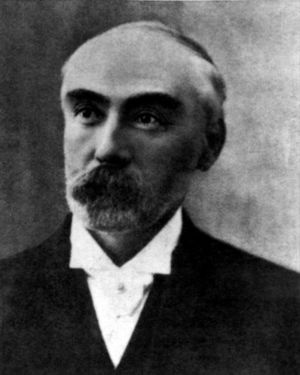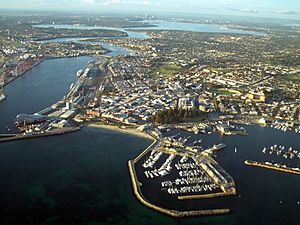C. Y. O'Connor facts for kids
Quick facts for kids
Charles Yelverton O'Connor
|
|
|---|---|

C. Y. O'Connor, 1891
|
|
| Born | 11 January 1843 Gravelmount House, Castletown, County Meath, Ireland
|
| Died | 10 March 1902 (aged 59) Robb Jetty, South Fremantle, Western Australia
|
| Occupation | Engineer |
| Spouse(s) | Susan Laetitia Ness (m.1873–1902; his death) |
| Children | 8, including Laetitia Kathleen and Bridget Yelverton |
Charles Yelverton O'Connor (born January 11, 1843 – died March 10, 1902) was a brilliant Irish engineer. He is famous for his amazing work in Western Australia. He built the Fremantle Harbour, which many people thought was impossible. He also created the Goldfields Water Supply Scheme, a huge pipeline that brought water to dry gold mining towns. His projects helped Western Australia grow a lot.
Contents
Early Life of C. Y. O'Connor
Charles O'Connor was born in a small country house in County Meath, Ireland. He was the youngest son in his family. He learned at home from his aunt before going to Bishop Foy's School. In 1859, he started training to be a railway engineer.
When he was 21, O'Connor moved to New Zealand. He became an assistant engineer there in 1866. One of his first big jobs was building a road through the Otira Gorge. This road made it easier to reach the gold fields on the West Coast. He worked on many important projects and became a top engineer. In 1873, he married Susan Laetitia Ness. They had eight children together.
In 1891, O'Connor moved to Western Australia with his family. He became the Engineer-in-Chief for the Public Works Department. This meant he was in charge of all major building projects for the government. His biggest challenges were building Fremantle Harbour and the Goldfields Water Supply Scheme.
Building Fremantle Harbour

Building Fremantle Harbour was one of O'Connor's greatest achievements. Many experts believed it was impossible to build a harbour at the mouth of the Swan River. They thought it would always need constant digging to keep it clear.
But O'Connor had a different idea. He proposed building the harbour right inside the river's entrance. Work started in 1892. They had to remove a lot of rock and sand. The harbour was successfully finished in 1903. In 1897, the first large ship, the Sultan, docked there. This proved O'Connor's plan was a success. Even today, the harbour is still used by big ships, showing how smart O'Connor's design was.
O'Connor's Railway Work
As Engineer-in-Chief, O'Connor also oversaw the railways in Western Australia. He helped improve existing train lines and planned new ones. He was in charge of finding water for the important Northam-Southern Cross railway route.
The Goldfields Water Supply Scheme


O'Connor is most famous for the Goldfields Water Supply Scheme, also known as the Goldfields Pipeline. This huge pipeline carries water about 530 kilometers (330 miles) from Perth to Kalgoorlie.
In the late 1800s, many people rushed to the gold fields in Western Australia. Towns like Coolgardie and Kalgoorlie grew very fast. But these areas were dry deserts with little water. In 1896, a plan was made to build a massive pipeline. It would pump water from a dam on the Helena River near Mundaring Weir in Perth. The water would be pumped in eight stages through a large pipe to Kalgoorlie. From there, it would go to different mining towns.
The lake created by the Mundaring Weir is now called Lake O'Connor. It still provides drinking water for towns along the pipeline today. This project was a huge engineering feat and changed life in the goldfields.
O'Connor's Final Days
O'Connor faced a lot of criticism from newspapers and politicians about the water scheme. Even though John Forrest, a strong supporter, had left his role, O'Connor continued to face attacks.
Charles O'Connor passed away on March 10, 1902, during a difficult time. Less than a year later, the Goldfields Water Supply Scheme was officially opened.
O'Connor's Lasting Impact
O'Connor's greatest achievements are the Fremantle Inner Harbour and the Goldfields Water Supply Scheme. The water scheme is considered one of Australia's most amazing engineering projects.
Many things are named after him to remember his work:
- The beach where he passed away is named after him.
- A statue of him by Tony Jones stands in the water there.
- The Monument to C. Y. O'Connor was built in 1911.
- His daughter, Kathleen O'Connor, became a well-known painter.
- The C. Y. O'Connor College of TAFE in Western Australia is named in his honor.
- The Division of O'Connor is an Australian voting area in Western Australia.
- A bronze statue of O'Connor by Pietro Porcelli stands at the Fremantle Port.
- O'Connor Primary School in Kalgoorlie-Boulder is also named after him.
- An Irish band called The Healys wrote a song about him.
Images for kids
-
Pietro Porcelli's statue of O'Connor, Fremantle Port. The statue faces north-east towards Fremantle Harbour.



